Globalization and the Rise of Contemporary Dance Styles

Understanding Globalization's Impact on Dance
Globalization has transformed various art forms, and dance is no exception. It facilitates cultural exchange, allowing different dance styles to intermingle and evolve. This cross-pollination enriches the dance landscape, creating new forms and hybrid styles that reflect a globalized society.
Dance is the hidden language of the soul.
For instance, traditional African dance elements have merged with hip-hop, resulting in vibrant new styles that resonate with youth across continents. This blending showcases not only the adaptability of dance but also how it serves as a universal language, bridging cultural gaps.
As we explore these contemporary dance styles, it becomes evident that globalization is not just about influence; it's about collaboration. Dancers from diverse backgrounds come together, sharing their techniques and storytelling methods, which leads to innovative performances that capture the essence of our interconnected world.
The Role of Technology in Dance Globalization
Technology plays a crucial role in disseminating dance styles around the globe. Social media platforms like Instagram and TikTok allow dancers to showcase their skills and gain international followings, making dance more accessible than ever. This instant sharing fosters trends that can go viral, influencing how dance is taught and performed.

For example, the viral success of dance challenges showcases how quickly a style can spread, often leading to its evolution as people put their unique spins on it. This phenomenon creates a dynamic dance ecosystem where styles continually adapt and grow, driven by the collective creativity of its participants.
Globalization Enriches Dance Forms
Cultural exchange through globalization leads to the emergence of new and hybrid dance styles that reflect our interconnected society.
Moreover, online tutorials and dance classes enable aspiring dancers to learn from world-renowned choreographers without geographical limitations. This accessibility not only democratizes dance education but also encourages a diverse range of interpretations and styles to flourish.
Cultural Appropriation vs. Appreciation in Dance
As dance styles blend globally, the conversation around cultural appropriation versus appreciation has become increasingly important. Cultural appropriation occurs when elements of one culture are used by another without understanding or respect, often leading to exploitation. In contrast, appreciation involves recognizing and honoring the origins of a dance style while incorporating it into one's own practice.
Culture is not a costume. It is a way of life.
Take, for instance, the use of traditional Native American dance in contemporary performances. When done respectfully, it can highlight the beauty of cultural diversity. However, if performed without context or acknowledgment, it risks reducing a rich heritage to mere aesthetic appeal.
Encouraging dialogue and education around these topics can foster a deeper understanding of how dance reflects cultural identities. By promoting appreciation instead of appropriation, dancers can create a more inclusive environment that respects the roots of each style.
Contemporary Dance Styles Emerging from Global Influences
The rise of contemporary dance styles can be directly attributed to the influence of globalization. Styles such as street dance, which originated in urban settings, have gained popularity worldwide, inspiring a generation of dancers to explore their roots. These contemporary forms often blend techniques from ballet, jazz, and other genres, creating an eclectic mix that speaks to our global society.
For example, the fusion of traditional Indian dance and modern hip-hop has led to captivating performances that tell unique stories. These innovative styles push the boundaries of traditional dance, allowing for greater expression and creativity.
Technology Amplifies Dance Reach
Social media and online platforms provide dancers with opportunities to showcase their skills globally, democratizing dance education and fostering innovation.
Furthermore, dance festivals around the world celebrate this diversity, showcasing performances that highlight various contemporary styles. These events not only entertain but also educate audiences about the cultural significance behind each dance form, fostering an appreciation for global artistic expressions.
The Influence of Global Events on Dance Trends
Global events, such as the Olympics or international dance competitions, significantly impact dance trends. These platforms provide exposure to diverse styles and encourage collaboration among dancers from different cultures. The result is a heightened interest in various dance forms, as audiences are captivated by the talent and artistry showcased on a global stage.
For example, the inclusion of breakdancing as an Olympic sport has brought renewed attention to hip-hop culture. This recognition not only validates the hard work of countless dancers but also inspires a new generation to explore and innovate within the genre.
Such events serve as a melting pot for ideas, where dancers can learn from each other and push the boundaries of their craft. By embracing this shared experience, the dance community strengthens its ties and fosters creativity that transcends borders.
Training and Education in a Globalized Dance World
With globalization shaping the dance landscape, training and education are also evolving. Dance schools and programs now incorporate a variety of styles, reflecting the rich tapestry of global influences. This exposure equips dancers with diverse skills, enabling them to adapt to various genres and collaborate effectively with others.
Additionally, online platforms have emerged as valuable resources for dancers seeking to expand their knowledge. Virtual workshops and classes allow students to learn from esteemed instructors worldwide, breaking down geographical barriers and fostering a more inclusive training environment.
Cultural Respect in Dance Practices
Understanding the difference between cultural appropriation and appreciation is essential for fostering an inclusive dance environment that honors diverse traditions.
As a result, today's dancers are not only skilled performers but also culturally aware artists who appreciate the significance of their craft. This blend of training and cultural understanding prepares them to thrive in an interconnected dance community.
The Future of Dance in a Globalized Context
As we look to the future, the impact of globalization on dance will only continue to grow. Emerging technologies, such as virtual reality and augmented reality, may further transform how we experience and engage with dance. These advancements can create immersive environments where audiences can interact with performances in unprecedented ways.
Moreover, the ongoing dialogue around cultural appreciation will shape the future of dance, encouraging more respectful and informed practices. As dancers continue to push boundaries, they will likely seek inspiration from an even broader range of cultural influences, leading to exciting new styles.

Ultimately, the future of dance is bright, filled with endless possibilities for collaboration and innovation. By embracing the global aspect of dance, artists can create powerful narratives that resonate with audiences worldwide, celebrating our shared human experience.